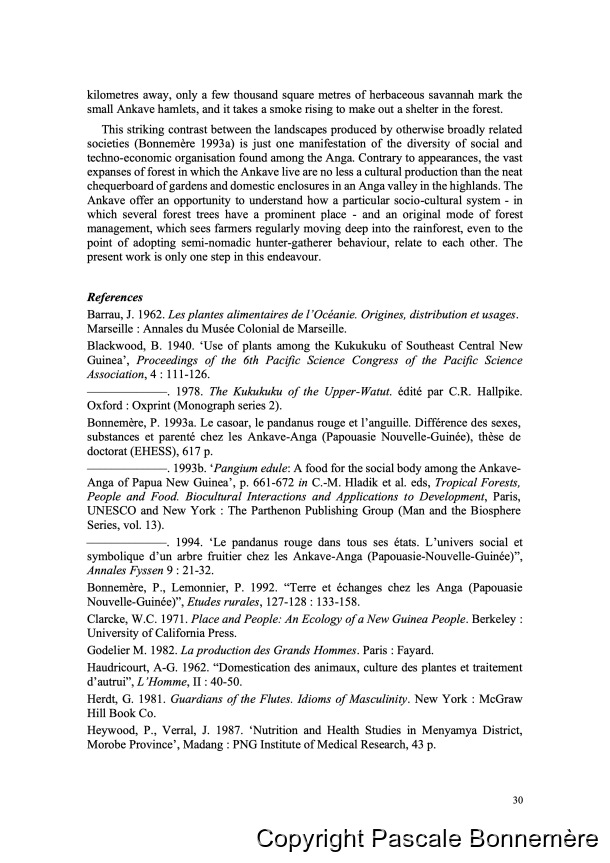|
|  [Note: this transcription was produced by an automatic OCR engine]
kilometres away, only a few thousand square metres of herbaceous savannah mark the
small Ankave hamlets, and it takes a smoke rising to make out a shelter in the forest.
This striking contrast between the landscapes produced by otherwise broadly related
societies (Bonnemère 1993a) is just one manifestation of the diversity of social and
techno-economic organisation found among the Anga. Contrary to appearances, the vast
expanses of forest in which the Ankave live are no less a cultural production than the neat
chequerboard of gardens and domestic enclosures in an Anga valley in the highlands. The
Ankave offer an opportunity to understand how a particular socio-cultural system - in
which several forest trees have a prominent place - and an original mode of forest
management, which sees farmers regularly moving deep into the rainforest, even to the
point of adopting semi-nomadic hunter-gatherer behaviour, relate to each other. The
present work is only one step in this endeavour.
References
Barrau, J. 1962. Les plantes alimentaires de l'Océanie. Origines, distribution et usages.
Marseille : Annales du Musée Colonial de Marseille.
Blackwood, B. 1940. ‘Use of plants among the Kukukuku of Southeast Central New
Guinea’, Proceedings of the 6th Pacific Science Congress of the Pacific Science
Association, 4 : 111-126.
. 1978. The Kukukuku of the Upper-Watut. édité par C.R. Hallpike.
Oxford : Oxprint (Monograph series 2).
Bonnemère, P. 1993a. Le casoar, le pandanus rouge et l’anguille. Différence des sexes,
substances et parenté chez les Ankave-Anga (Papouasie Nouvelle-Guinée), thèse de
doctorat (EHESS), 617 p.
. 1993b. ‘Pangium edule: A food for the social body among the Ankave-
Anga of Papua New Guinea’, p. 661-672 in C.-M. Hladik et al. eds, Tropical Forests,
People and Food. Biocultural Interactions and Applications to Development, Paris,
UNESCO and New York : The Parthenon Publishing Group (Man and the Biosphere
Series, vol. 13).
. 1994. ‘Le pandanus rouge dans tous ses états. L’univers social et
symbolique d’un arbre fruitier chez les Ankave-Anga (Papouasie-Nouvelle-Guinée)”,
Annales Fyssen 9 : 21-32.
Bonnemère, P., Lemonnier, P. 1992. “Terre et échanges chez les Anga (Papouasie
Nouvelle-Guinée)”, Etudes rurales, 127-128 : 133-158.
Clarcke, W.C. 1971. Place and People: An Ecology of a New Guinea People. Berkeley :
University of California Press.
Godelier M. 1982. La production des Grands Hommes. Paris : Fayard.
Haudricourt, A-G. 1962. “Domestication des animaux, culture des plantes et traitement
d’autrui”, L'Homme, I] : 40-50.
Herdt, G. 1981. Guardians of the Flutes. Idioms of Masculinity. New York : McGraw
Hill Book Co.
Heywood, P., Verral, J. 1987. ‘Nutrition and Health Studies in Menyamya District,
Morobe Province”, Madang : PNG Institute of Medical Research, 43 p.
30
�
|